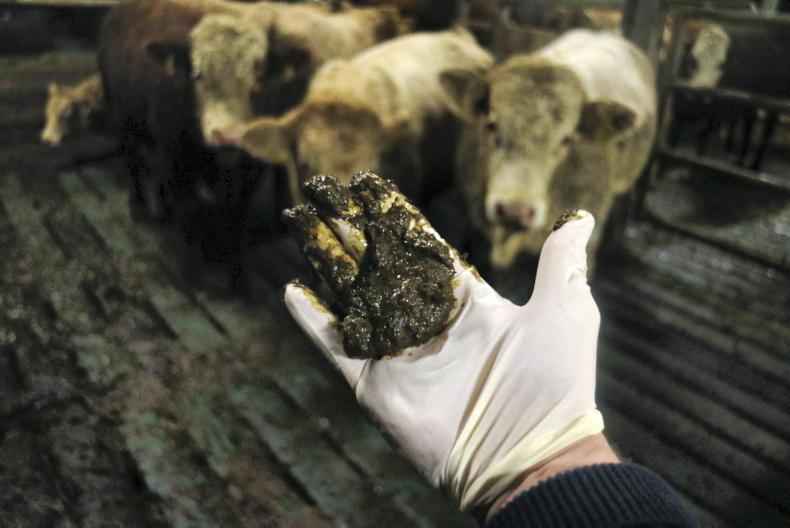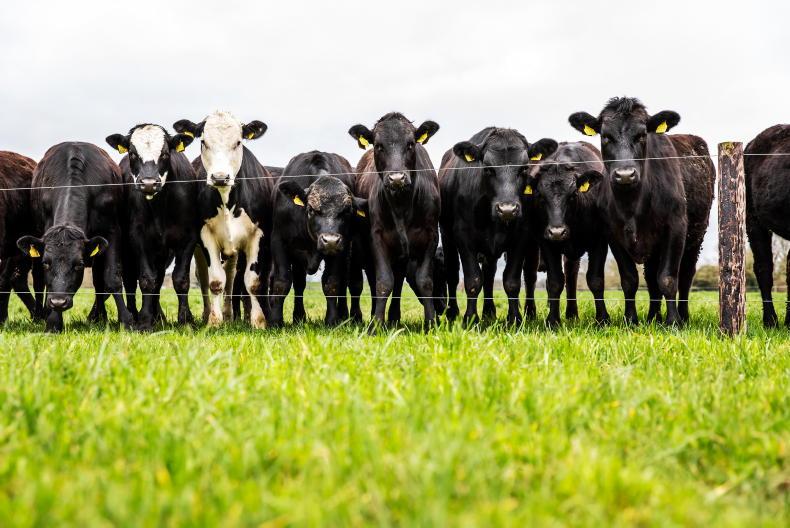First season grazers are the animals most at risk of developing parasite problems over the grazing season, particularly dairy calves and suckler calves born last autumn.
As the season progresses over summer, there is a build-up of gut worm larvae on the pastures, which can overwhelm animals, leading to clinical disease.
Even in mild cases without obvious signs of scour or weight loss, there can be performance losses where animals fail to meet their target weights.
Develop a parasite control plan with your veterinary practitioner or adviser to minimise these losses. Any control plan should be tailored to the location and management practices specific to your farm.
Wormers should only be given when needed and not used unnecessarily, because their overuse is associated with anthelmintic resistance, leading to wormers no longer working effectively. Animals develop immunity to gut worms and lungworms after exposure over time, and younger animals in their first grazing season are the most susceptible to clinical disease.
Suckler calves with their dams are at low risk at the start of the season and do not usually need gut worm treatments until late summer around weaning.
Dairy calves should be closely monitored for clinical signs like diarrhoea and coughing, and a faecal egg count six to eight weeks after turnout, along with tracking average daily weight gains, can be used as an indicator of when calves need treatment.
Strategic treatments can also be used to limit the pasture contamination. Calves at high risk of disease should be placed on clean pastures with a low risk of contamination.
These low-risk pastures are those grazed by older cows or sheep in the previous year, or aftergrass and reseeded land.
If calves are placed on the same pasture year after year, there is a higher risk of disease earlier in the season, as the larvae contaminating the pastures from the previous summer may survive over the winter.
Second season grazers have usually developed some immunity to gut worms if they had adequate exposure in the previous grazing season, but they should still be monitored.
Continuous treatments or overtreatment in calves can interfere with this immunity developing.
Adult animals do not usually need treatment for gut worms, but should still be monitored.

Dung samples must be fresh.
Highest risk
For lungworm, the highest risk period is late summer to autumn, but it can be unpredictable, with some outbreaks early in the season. Cattle – particularly youngstock – should be monitored and the whole group treated as soon as they show signs of coughing or breathing difficulties.
Cattle do not develop immunity to liver fluke with age and all animals on farms with a risk of liver fluke should be treated, usually towards the end of the grazing season or going into housing.
The high-risk regions for liver fluke are in northwest Ireland.
Monitoring with
faecal egg counts
Faecal egg counts measure the number of eggs shed in the dung produced by adult gut worms. Calves shed more eggs than adult animals, resulting in greater contamination of the pastures.
Faecal egg counts can be a useful tool for monitoring when pasture contamination increases, but should be interpreted in the context of previous treatments and the time of year. Counts should be low after dosing, and if not, this may be an indicator of resistance to the dose, which needs to be investigated.
Taking a good-quality dung sample is important for reliable results:
Freshness is key. Take samples from fresh, warm dung and send them off to your veterinary practitioner or laboratory within 24 hours. Retake them if there is a delay in sending.Take samples from 10-15 animals. Approach the group when they are resting, as they will often pass dung as they walk away or gather them into the corner of a field or pen for a short time.Roughly a tablespoon of dung per animal is enough and place the samples in leakproof containers with a screw cap. The advice is to dose where the result is over 200/250 eggs per gramme along with reduced weight gains. There are some good practices around dosing which should be considered before you start:
Read the package insert on how best to apply the treatment. Pour-ons should be applied as directed on the back of the animal over clean areas (no mud or dung). Oral wormers should be dosed over the back of the tongue so that they are swallowed. Confirm the withdrawal times for meat and milk before use.Calibrate your dosing equipment – check that the amount delivered by the dosage gun is accurate. Use the right dose amount – dose according to the weight of the heaviest animal in a group. Split the group if the weight varies by a large amount. Use the right product that is effective against the target parasite and its life cycle stage.Record the products used, as well as the dates and animals dosed.
First season grazers are the animals most at risk of developing parasite problems over the grazing season, particularly dairy calves and suckler calves born last autumn.
As the season progresses over summer, there is a build-up of gut worm larvae on the pastures, which can overwhelm animals, leading to clinical disease.
Even in mild cases without obvious signs of scour or weight loss, there can be performance losses where animals fail to meet their target weights.
Develop a parasite control plan with your veterinary practitioner or adviser to minimise these losses. Any control plan should be tailored to the location and management practices specific to your farm.
Wormers should only be given when needed and not used unnecessarily, because their overuse is associated with anthelmintic resistance, leading to wormers no longer working effectively. Animals develop immunity to gut worms and lungworms after exposure over time, and younger animals in their first grazing season are the most susceptible to clinical disease.
Suckler calves with their dams are at low risk at the start of the season and do not usually need gut worm treatments until late summer around weaning.
Dairy calves should be closely monitored for clinical signs like diarrhoea and coughing, and a faecal egg count six to eight weeks after turnout, along with tracking average daily weight gains, can be used as an indicator of when calves need treatment.
Strategic treatments can also be used to limit the pasture contamination. Calves at high risk of disease should be placed on clean pastures with a low risk of contamination.
These low-risk pastures are those grazed by older cows or sheep in the previous year, or aftergrass and reseeded land.
If calves are placed on the same pasture year after year, there is a higher risk of disease earlier in the season, as the larvae contaminating the pastures from the previous summer may survive over the winter.
Second season grazers have usually developed some immunity to gut worms if they had adequate exposure in the previous grazing season, but they should still be monitored.
Continuous treatments or overtreatment in calves can interfere with this immunity developing.
Adult animals do not usually need treatment for gut worms, but should still be monitored.

Dung samples must be fresh.
Highest risk
For lungworm, the highest risk period is late summer to autumn, but it can be unpredictable, with some outbreaks early in the season. Cattle – particularly youngstock – should be monitored and the whole group treated as soon as they show signs of coughing or breathing difficulties.
Cattle do not develop immunity to liver fluke with age and all animals on farms with a risk of liver fluke should be treated, usually towards the end of the grazing season or going into housing.
The high-risk regions for liver fluke are in northwest Ireland.
Monitoring with
faecal egg counts
Faecal egg counts measure the number of eggs shed in the dung produced by adult gut worms. Calves shed more eggs than adult animals, resulting in greater contamination of the pastures.
Faecal egg counts can be a useful tool for monitoring when pasture contamination increases, but should be interpreted in the context of previous treatments and the time of year. Counts should be low after dosing, and if not, this may be an indicator of resistance to the dose, which needs to be investigated.
Taking a good-quality dung sample is important for reliable results:
Freshness is key. Take samples from fresh, warm dung and send them off to your veterinary practitioner or laboratory within 24 hours. Retake them if there is a delay in sending.Take samples from 10-15 animals. Approach the group when they are resting, as they will often pass dung as they walk away or gather them into the corner of a field or pen for a short time.Roughly a tablespoon of dung per animal is enough and place the samples in leakproof containers with a screw cap. The advice is to dose where the result is over 200/250 eggs per gramme along with reduced weight gains. There are some good practices around dosing which should be considered before you start:
Read the package insert on how best to apply the treatment. Pour-ons should be applied as directed on the back of the animal over clean areas (no mud or dung). Oral wormers should be dosed over the back of the tongue so that they are swallowed. Confirm the withdrawal times for meat and milk before use.Calibrate your dosing equipment – check that the amount delivered by the dosage gun is accurate. Use the right dose amount – dose according to the weight of the heaviest animal in a group. Split the group if the weight varies by a large amount. Use the right product that is effective against the target parasite and its life cycle stage.Record the products used, as well as the dates and animals dosed. 






 This is a subscriber-only article
This is a subscriber-only article










SHARING OPTIONS: